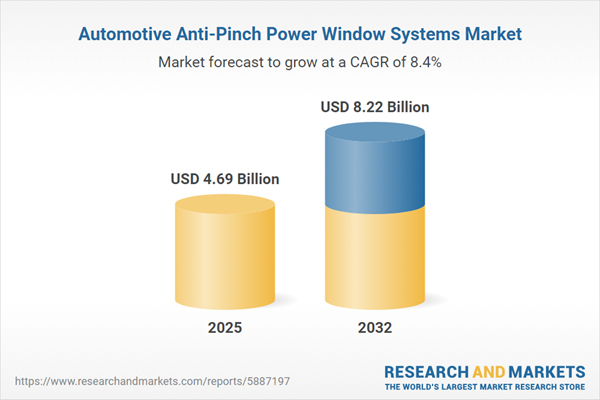Speak directly to the analyst to clarify any post sales queries you may have.
Senior industry leaders in the automotive sector face a shifting landscape as automotive anti-pinch power window systems advance in response to regulatory demands and evolving safety expectations. Adapting operations and investment strategies in this space is essential for building operational resilience and capturing growth opportunities.
Market Snapshot: Automotive Anti-Pinch Power Window Systems
The automotive anti-pinch power window systems market is undergoing a pivotal transformation driven by more stringent safety regulations and the rise of smart vehicle technologies. Regulatory authorities are stepping up compliance pressure, and manufacturers are responding by integrating advanced sensors, modular digital controls, and adaptive electronics. This evolution is further shaped by rising safety awareness in both established and emerging markets, catalyzing investments in platform flexibility and regional compatibility. As passenger and commercial vehicles incorporate more connected features, suppliers focus on delivering solutions that meet modernized vehicle safety requirements and offer seamless assembly for new vehicle architectures.
Scope & Segmentation
This executive report focuses on high-value insights and segmentation relevant to procurement, investment, and operational decision-making in the automotive anti-pinch power window systems market. Strategic coverage across vehicle types, technology adoption, and regional regulatory trends supports an informed approach to adopting and customizing these solutions.
- Vehicle Types: Analysis covers both passenger cars and commercial vehicles, emphasizing strategic adoption trends influenced by safety and modernization pressures across fleets and individual vehicles.
- Sales Channels: Explores original equipment manufacturer (OEM) and aftermarket sales, highlighting competitive opportunities in first-time vehicle fitment as well as in-component replacement cycles for ongoing vehicle maintenance.
- Motor Technologies: Addresses the evolution and selection of brushless DC, standard DC, and stepper motors, focusing on efficiency, adaptability, and the alignment of motor types with differing vehicle performance targets.
- Window Positions: Examines specifications for front and rear installations, exploring how diverse system integration supports different user needs and enhances overall vehicle occupant safety.
- Sensor Technologies: Details integration of force, infrared, and optical sensors, with emphasis on the advancement of hazard detection capabilities and their interface with networked control systems.
- Regions: Provides insights on the Americas, Europe, Middle East & Africa, and Asia-Pacific, analyzing the interplay between regulation, deployment patterns, and localized compliance initiatives.
- Country Coverage: Offers direct assessment of localized market dynamics and best practices for the United States, Germany, India, China, Brazil, and South Africa, with a focus on adapting to shifting regulatory and consumer preferences.
- Leading Companies Analyzed: Evaluates innovation and competitive strategies from key players, including Robert Bosch GmbH, Continental AG, ZF Friedrichshafen AG, Aisin Seiki Co., Ltd., DENSO Corporation, Magna International Inc., Nidec Corporation, Valeo SA, Johnson Electric Holdings Limited, and NSK Ltd.
Key Takeaways for Senior Decision-Makers
- Prioritizing flexible system design enables organizations to adapt product offerings to unique regulatory requirements in multiple global markets, supporting broader geographic reach and compliance efficiency.
- Integrating high-efficiency motors and advanced sensor technologies accelerates compatibility with the latest electric vehicle platforms and promotes smoother alignment within the broader automotive software ecosystem.
- Applying predictive analytics within maintenance operations reduces risk of unplanned downtime and drives greater reliability in vehicle performance, allowing better resource allocation.
- Focusing on agile product development and compliance strategies prepares organizations to quickly respond to fast-changing local regulatory mandates and maintain market eligibility.
- Reinforcing supplier diversification and strengthening regional sourcing strategies mitigates risks associated with component cost variability and supply chain disruptions.
- Integrating innovations in embedded software and multi-sensor systems helps organizations meet the increasing safety expectations of both regulators and vehicle occupants, supporting competitive differentiation.
Tariff Impact and Supply Chain Adaptation
Fluctuations in global tariff policies have sharpened the focus on electronic component pricing and supply chain security for anti-pinch power window system manufacturers. In response, industry leaders are expanding local manufacturing, building resilient supplier networks, and deepening partnerships with technology vendors. These steps are central to maintaining delivery reliability and ensuring production continuity in an evolving regulatory environment.
Methodology & Data Sources
Findings are based on direct interviews with senior industry stakeholders, comprehensive patent analysis, and an in-depth review of international regulatory records. This methodology ensures that insights are actionable, validated, and directly aligned with executive decision-making needs.
Why This Report Matters
- Enables executive teams to design technology selection frameworks and supplier adaptation strategies tailored to the automotive anti-pinch power window systems market.
- Equips leaders with reliable intelligence on regulatory developments, evolving customer expectations, and competitive innovation, supporting robust market positioning and risk management.
- Delivers evidence-based analysis to support planning for investment and compliance, building organizational agility in a dynamic regulatory context.
Conclusion
Targeted investment in technology and resilient supply chains ensures organizations effectively navigate evolving regulations and changing buyer demands. Agility and innovation remain vital for sustained growth in the automotive anti-pinch power window systems market.
Additional Product Information:
- Purchase of this report includes 1 year online access with quarterly updates.
- This report can be updated on request. Please contact our Customer Experience team using the Ask a Question widget on our website.
Table of Contents
3. Executive Summary
4. Market Overview
7. Cumulative Impact of Artificial Intelligence 2025
Companies Mentioned
The companies profiled in this Automotive Anti-Pinch Power Window Systems market report include:- Robert Bosch GmbH
- Continental AG
- ZF Friedrichshafen AG
- Aisin Seiki Co., Ltd.
- DENSO Corporation
- Magna International Inc.
- Nidec Corporation
- Valeo SA
- Johnson Electric Holdings Limited
- NSK Ltd.
Table Information
| Report Attribute | Details |
|---|---|
| No. of Pages | 188 |
| Published | October 2025 |
| Forecast Period | 2025 - 2032 |
| Estimated Market Value ( USD | $ 4.69 Billion |
| Forecasted Market Value ( USD | $ 8.22 Billion |
| Compound Annual Growth Rate | 8.3% |
| Regions Covered | Global |
| No. of Companies Mentioned | 11 |









